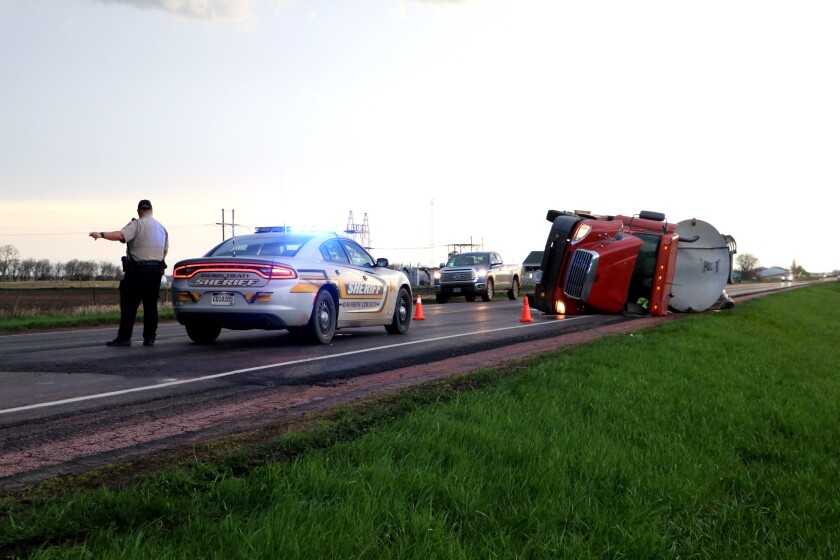PIERRE, S.D. — Roughly a month and a half after a deadly derecho left behind widespread damage across eastern South Dakota, federal funding is on the way after the president approved a disaster declaration spanning 20 counties and two reservations.
Gov. Kristi Noem announced Wednesday afternoon that President Joe Biden approved her request for a presidential disaster declaration, opening the door for federal funds and assistance from the Federal Emergency Management Agency (FEMA).
“This is good news for those in our state who were impacted by this severe weather,” Noem said. “I appreciate FEMA giving us a response. This means FEMA can start providing assistance in a timely manner.”
Monies disbursed by FEMA only applies to damage dealt to public institutions and infrastructure, such as highways, government buildings, schools, dams, public parks and other public facilities. In her request, Noem cited $6.7 million in damages.
Though a specific timeline was not provided, FEMA staff members will be arriving soon in the state to help begin the assistance efforts with governmental and certain private-non-profit entities. The Department of Public Safety’s Office of Emergency Management will be the state agency assigned to help coordinate the assistance.
ADVERTISEMENT

Public infrastructure damage assistance will be provided to the counties of Aurora, Beadle, Bon Homme, Brookings, Clay, Codington, Day, Deuel, Grant, Hamlin, Hanson, Hutchinson, Kingsbury, Lake, McCook, Miner, Minnehaha, Moody, Roberts and Turner, as well as the Flandreau Indian Reservation and Lake Traverse Reservation.
The disaster declaration stems from a massive storm system that swept through the state on May 12. The storms dealt significant damage to both public and private property throughout the impacted areas.
In a letter earlier this month requesting the disaster declaration, Noem wrote that the storm resulted in two deaths, a preliminary number of 14 reported tornadoes and wind gusts of more than 100 mph in some places. The storms also resulted in the temporary closure of roads and highways as nearly 70,000 customers experienced power outages.

In McCook County, winds of over 90 mph uprooted trees, knocked down power lines and tipped over semis. The roof of a local nursing home was almost entirely torn off, forcing the evacuation and relocation of residents to other facilities in the surrounding area. To the east, in Montrose, an entire hog barn collapsed on top of livestock, while peak winds of 107 mph in Tripp, to the southwest, dented massive grain bins at the elevator.
B.J. Stiefvater, emergency manager for McCook County, estimated that damages in his county had easily surpassed $100 million to private and public property. Also serving as the owner of the local ambulance service, he was amazed that the only injury reported was a banged elbow.
The storm also destroyed a public school building in Castlewood, where Noem grew up.
“An EF2 tornado, with wind speeds estimated at 120 mph, passed through the town of Castlewood,” Noem wrote in her request. “Several structures and homes sustained significant damage, including the Castlewood school.”
Not all counties affected by the storm were included in the presidential disaster declaration, because not all counties declared a disaster.
ADVERTISEMENT
According to Stiefvater, county officials must survey damage immediately following a storm, and declare a disaster, noting that the damages sustained to public property exceeds the county’s ability to fund repairs — a threshold which varies from county to county.
The state will then field reports from each county that has declared a disaster, and tally all damages from each affected county. If the total value is higher than the state’s ability to fund repairs, the state can request a presidential disaster declaration.
Davison County, for example, was not included in Noem’s request to Biden, because it didn’t meet the county’s damage threshold. Davison County Emergency Manager Jeff Bathke said the county would need to see roughly $82,000 in public infrastructure damage to declare a disaster.
For context, Bathke said the 2019 flood caused $4.1 million in damage to public infrastructure in the county.
Though separate from the declaration approved by Biden, in some disaster declarations, FEMA has recovery programs for private individuals. Phil Wernisch, a representative for FEMA, said individual assistance was not included in this disaster declaration. More information regarding individual assistance can be found on their website.






























